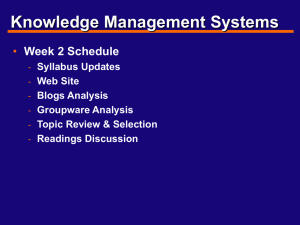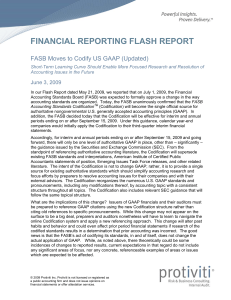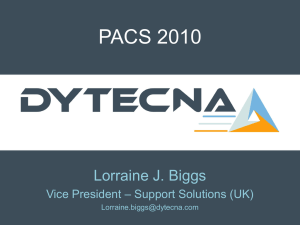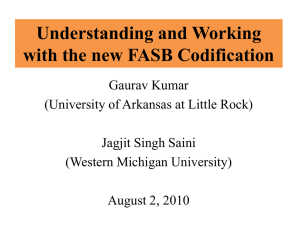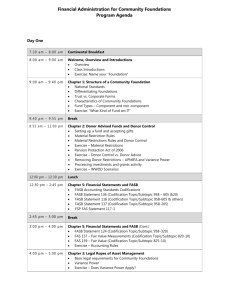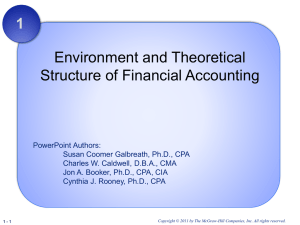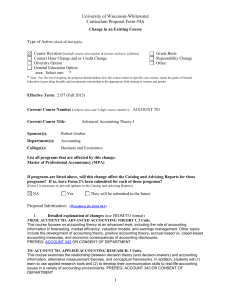A Structural Model of the Determinants of XBRL Adoption
advertisement
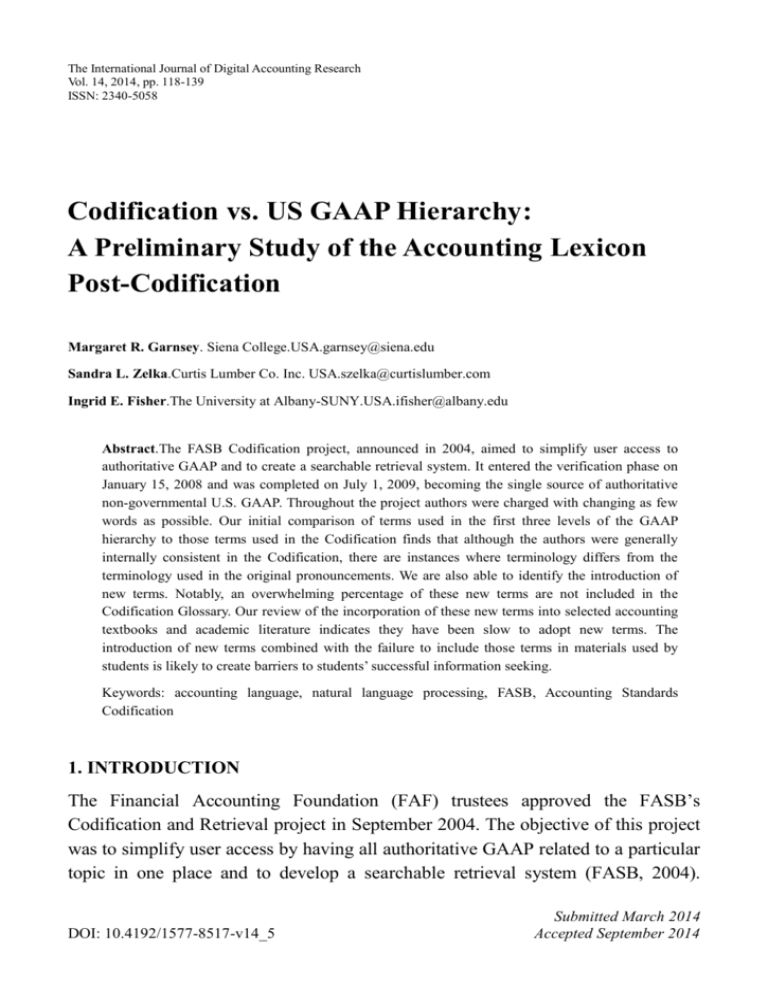
The International Journal of Digital Accounting Research Vol. 14, 2014, pp. 118-139 ISSN: 2340-5058 Codification vs. US GAAP Hierarchy: A Preliminary Study of the Accounting Lexicon Post-Codification Margaret R. Garnsey. Siena College.USA.garnsey@siena.edu Sandra L. Zelka.Curtis Lumber Co. Inc. USA.szelka@curtislumber.com Ingrid E. Fisher.The University at Albany-SUNY.USA.ifisher@albany.edu Abstract.The FASB Codification project, announced in 2004, aimed to simplify user access to authoritative GAAP and to create a searchable retrieval system. It entered the verification phase on January 15, 2008 and was completed on July 1, 2009, becoming the single source of authoritative non-governmental U.S. GAAP. Throughout the project authors were charged with changing as few words as possible. Our initial comparison of terms used in the first three levels of the GAAP hierarchy to those terms used in the Codification finds that although the authors were generally internally consistent in the Codification, there are instances where terminology differs from the terminology used in the original pronouncements. We are also able to identify the introduction of new terms. Notably, an overwhelming percentage of these new terms are not included in the Codification Glossary. Our review of the incorporation of these new terms into selected accounting textbooks and academic literature indicates they have been slow to adopt new terms. The introduction of new terms combined with the failure to include those terms in materials used by students is likely to create barriers to students‘ successful information seeking. Keywords: accounting language, natural language processing, FASB, Accounting Standards Codification 1. INTRODUCTION The Financial Accounting Foundation (FAF) trustees approved the FASB‘s Codification and Retrieval project in September 2004. The objective of this project was to simplify user access by having all authoritative GAAP related to a particular topic in one place and to develop a searchable retrieval system (FASB, 2004). DOI: 10.4192/1577-8517-v14_5 Submitted March 2014 Accepted September 2014 119 The International Journal of Digital Accounting Research Vol. 14 GAAP had a hierarchical structure as described in FAS 162 (FASB, 2008a). It was organized by type (Standards, Practice Bulletins, etc.) rather than by topic. The Codification project integrated all GAAP related to each topic using a standard structure. The process was intended to ensure that the current standards ―are included with minimal modification‖ (McEwen et al., 2006). Because the intent was to accurately reflect existing standards, "authors were instructed to change as few words as possible when authoring their topics" for the Codification (FASB, 2008b). However, the FASB Accounting Standards CodificationTM Notice to Constituents specifically noted a few changes in language, ―Over the years, standards have used numerous terms to describe an entity, such as ‗company,‘ ‗organization,‘ ‗enterprise,‘ ‗firm,‘ ‗preparer,‘ and so forth. To provide consistency, the FASB adopted the term ‗entity‘ as the appropriate term. Because the FASB adopted the term ‗entity‘ as the common term throughout the Codification, the FASB adopted the term ‗intra-entity‘ as the replacement for ‗intercompany‘. The FASB has provided a definition for ‗intra-entity‘ and intends for the terms ‗intraentity‘ and ‗intercompany‘ to be interchangeable. Similar to the multiple terms used to refer to an entity, standards have used various words or phrases to refer to a requirement, such as ‗should,‘ ‗shall,‘ ‗is required to,‘ ‗must,‘ and others. The FASB believes such terms represent the same concept—the requirement to apply a standard. To establish consistency, the Codification uses the term ‗shall‘ throughout the standards Sections‖ (FASB, 2008b). The Codification simplified the task of finding current GAAP if one knows which topic to examine. This is true because all GAAP related to a specific topic was located in one place under the Codification rather than possibly spread over many original pronouncements, as was the case under the prior GAAP Hierarchy. The reorganization via topic should provide better research capability, however, with the introduction of new terms, some of this efficiency is lost. The difficulty arises if a problem is not well defined or the individual doing the research has a limited vocabulary to describe their need. Garnseyet al. (2009) found that almost 30% of students misinterpreted an accounting question as an environmental problem rather than a contingent liability issue in research on student searches. Borthick et al. (2001) investigated the effect of ambiguity on query development in relational databases. They found that accuracy and efficiency were inversely related to the ambiguity of information requests. Garnsey, Zelka & Fisher Codification vs. US GAAP Hierarchy…120 In cases where the applicable topic is not specifically known, searching based on natural language is used. Natural language often gives unsatisfactory results due to the diversity of vocabulary. It is difficult for a user to predict what terms have been used by authors of relevant documents. In the case of GAAP, users may be more familiar with terms used in the original pronouncements. As noted by the FASB Accounting Standards CodificationTM Notice to Constituents, new terms have been intentionally introduced, such as ‗intra-entity‘. However, a cross-listing dictionary of interchangeable/replaced terms was not included in the Codification, thereby complicating research and retrieval. In January 2008, the FASB Accounting Standards Codification (the Codification) entered a verification phase. During the one-year verification, constituents were ―encouraged to use the online Codification Research System … to research accounting issues and provide feedback" (FASB, 2008c). The motivation of this paper is to provide an understanding and description of the impact of the Codification on the accounting lexicon. Wecompare the language used in the authoritative literature issued by the FASB, its predecessors, and the AICPA to that used in the Codification. The objectives of this work are to determine if language in the Codification changed appreciably from what was originally used, to identify where the changes in terminology exist and to begin to explore the implications of such discrepancies. We address two research questions. RQ1: Has the terminology used in the Codification changed significantly from the terminology used previously in the authoritative literature? A change in language maycreate retrieval problems for the users of the Codification. Garnsey and Hotaling (2007) established that without explicit prompts students struggle to select appropriate retrieval terms from memory. Notably, the Codification search feature currently augments users‘ search results with the option of narrowing their search by a ―related‖ term or industry. However, the use of ―related‖ term in the Codification is not the same as in linguistics where a related term is one that has an associative relationship with the primary term. An associative relationship is defined by the International Organization for Standardization (1986) as one where a pair of terms is not equivalent, nor are they hierarchically related yet there is a mental association strong enough to call for explicit linkage between the terms (as in a thesaurus). In contrast, the related terms offered by the Codification are quite often either broader/narrower terms or other unrelated topics altogether. As one example, a Codification search using the term ―defined benefit plan‖ yields ―other 121 The International Journal of Digital Accounting Research Vol. 14 comprehensive income‖ as a related term. The uses of new terminology, in the Codification, combined with inadequate user prompts, are likely to obfuscate retrieval efforts. RQ2: Have sources commonly used by students incorporated new vocabulary used by the Codification? We present a discussion of the new terms and their adoption in accounting research and education materials to illustrate that the academic and pedagogical literature has significantly lagged the Codification project in its incorporation of new terms. The remainder of this paper reviews specific, related literature followed by a description of the methodology and a discussion of the results. The final section presents conclusions and limitations of this study as well as identifies opportunities for future research. We emphasize that this work is a preliminary exploration of the use of Codification terms in a limited corpus (as defined in the methodology). Larger scale corpora, such as contained in Google Scholar, are beyond the scope of this initial study. 2. SELECTED RELATED LITERATURE 2.1 The Accounting Lexicon Research on language used in accounting literature is sparse. Notwithstanding Goldberg‘s (1965) statement that ―it is scarcely an exaggeration to say that the problem of communication is the axial problem in accounting‖ and Haried‘s (1972) identification of the use of technical accounting terms that have different meanings in common use or other disciplines as problematic, little research on the accounting lexicon followed. Much of the work has concentrated on financial statements. Riahi-Belkaoui(1995) examined forty-two studies conducted between 1952 and 1993. He concluded that financial statement readability is difficult for the average reader and that a differential understanding between user groups existed for accounting terms. Tetlocket al.(2007) quantified the language used in financial news stories. Their main finding was that negative words in the financial press forecasted low firm earnings. Rutherford(2005) used word frequencies to identify genre rules in U.K. Operating and Financial Reviews. In the past decade, computational linguistics techniques have been used in the analysis of accounting terminology. Gangolly and Tam(2002) argued in support of utilizing techniques in computational linguistics and lexicography based on the Garnsey, Zelka & Fisher Codification vs. US GAAP Hierarchy…122 statistical analysis of corpora for the generation of dictionaries and thesauri. They analyzed year 2000 electronic EDGAR filings with the Securities & Exchange Commission as a first step. Grant and Conlon (2006) developed and tested an automated system for extracting information on stock options from the notes to the financial statements contained in the EDGAR database. In their investigation into how new terms are incorporated into the accounting lexicon, Garnsey and Fisher (2008) used computational linguistics on authoritative pronouncements and financial statements to identify new accounting terms. Bloomfield (2008) points out the role of standard setters in creating new accounting terms to better reflect the substance of transactions where existing terminology is misused or where technological or commercial changes signal a need for a new term. Evans (2010) uses linguistic theories to explore the motivations for language change in accounting. She highlights the need to describe new concepts and socio-cultural change as significant motivators for change in accounting language. Davis et al. (2011) analyze approximately 23,000 earning press releases using a measure of managers‘ net optimistic language and conclude that the measure is positively associated with future firm ROA. Finally, Riley et al. (2014) demonstrates that positive (negative) financial information is associated with more concrete (abstract) language used in earnings press releases. 2.2 Information Seeking and Retrieval In contrast to research on accounting language, a large body of literature has been published on the information seeking behavior of professionals. The emphasis of those studies was on professionals from different disciplines: in the 1950s and 1960s, scientists and engineers; 1970s, social scientists; and 1980s and 1990s, scholars in the arts and humanities (Bates, 1996). Leckie et al. (1996) found information seeking activity contingent on two major factors: sources and awareness. They state, ―Research has shown that professionals are likely to consult a source for information if they are familiar with it and have had prior success using that source for an earlier problem or similar need‖ (Leckie et al., 1996). More recently, Kerins et al. (2004) reported the results of two empirical studies which explored the information seeking behavior of students studying for professional careers. They found the students exhibited similar patterns to those identified by Leckieet al.(1996). 123 The International Journal of Digital Accounting Research Vol. 14 Khosrowjerdi and Iranshahi (2011) found a positive and significant relationship between prior knowledge and information-seeking behavior in graduate students. Lee (2008) explored how undergraduates look for information. Her study, of fifteen students in various fields of study, found that the Internet was used as a first source, followed by the university library‘s collection, and participants own collection of information sources (including textbooks from current or previous classes). This is similar to the results of studies from Project Information Literacy (PIL) which have shown that the top three sources for course-related research are: course readings, search engines (including Google) and scholarly research databases (Head, 2013). The vast majority of students surveyed for PIL used ―the same few information sources, regardless of which research contexts they were trying to satisfy‖.Denison and Montgomery (2012)studied college students‘ perceptions of their experiences performing information-seeking and retrieval.The students found the process ―difficult and frustrating‖. In agreement with other studies (Biddix et al., 2011; Head and Eisenberg, 2009), Denison and Montgomery (2012) found students may compromise the quality of their information retrieval by choosing sources that are less reliable but are more conveniently located. Other research in information retrieval has shown that individuals have greater success in locating an object as the number of access points increase (Gomez et al., 1990). More specifically, in the accounting domain, Garnsey et al.(2009) found that providing students with a list of possible retrieval terms increased their ability to accurately research accounting questions. The standardization of language in the Codification could have a detrimental effect on information retrieval using natural language processing if the information need is not well defined and/or the user has a limited vocabulary on the subject. As stated in Garnsey et al.(2009), students have difficulty in defining problems accurately. The replacement/addition of terms in the Codification only exacerbates the issues surrounding student research. We compare Codification terms to terms used in published research in accounting as well as textbooks and identify differences that may be indicative of possible complications for users of those materials in locating specific guidance in the Codification. Garnsey, Zelka & Fisher Codification vs. US GAAP Hierarchy…124 3. METHODOLOGY GAAP was formerly categorized into a hierarchy with each level having less authority than the previous one. See Table 1 for the GAAP hierarchy as promulgated by FAS162 (FASB, 2008a). A. FASB Standards and Interpretations FASB Staff Positions AICPA Accounting Research Bulletins Accounting Principles Board Opinions B. FASB Technical Bulletins If cleared by the FASB: AICPA Industry Audit and Accounting Guides AICPA Statements of Position C. If cleared by the FASB: AICPA Accounting Standards Executive Committee Practice Bulletins Consensus positions of the Emerging Issues Task Force Appendix D of EITF Abstracts D. FASB Implementation Guides (Q&A) Not cleared by the FASB: AICPA Accounting Interpretations AICPA Industry Audit and Accounting Guides AICPA Statements of Position not cleared by the FASB Practices that are widely recognized and prevalent Table 1: GAAP Hierarchy The vocabulary used for this study was the one used by Garnsey(2009). In a comparison of the Codification and the first 3 levels of the GAAP hierarchy, she found the authors of the Codification were generally internally consistent, however, instances of terminology different from the original pronouncements did exist. Using the data from Garnsey (2009) we identified those terms which were unique to the Codification.As an extension of thisresearch, we reviewed accounting research publications and copyrighted textbooks post codification to determine whether new codification terms were included. Specifically, we reviewed copyright and publication dates from January 2010 to present. We assumed publications printed prior to January 2010 would have had submission deadlines prior to the release of the Codification. The review included the following terms, which appear only in the Codification: nfps, recipient entity, on-going entity, intra-entity. The review also included synonymous terms used in the accounting pronouncements prior to codification: not-for-profit, recipient company, going concern and intercompany. All textbooks included in the review incorporated the Codification as referenced in conjunction with the former FASB pronouncement. Textual and index searches 125 The International Journal of Digital Accounting Research Vol. 14 were performed on each text. The textbook subject matters were limited to Intermediate Accounting and Advanced Accounting. Publishers included John Wiley and Sons, McGraw-Hill Irwin, Pearson, and Cengage Learning. The accounting research review included submissions printed in research and practitioner journals: the Journal of Accountancy, the Accounting Review, Issues in Accounting Education and Accounting Horizons. All elements of the publication were included in the review including sections related to official releases. 4. ANALYSIS 4.1 Overview of the Data Summary statistics on the collections are given in Table 2. GAAP Hierarchy Codification Size (mg) 43.6 9.31 No. of terms 21,633 11,006 No. terms appearing once 4,137 2,523 No. of terms not in other collection 4,568 264 Table 2: Summary Statistics Table 3 shows the fifteen most frequently occurring terms in each collection. GAAP Hierarchy Codification Term Freq Term Freq asset(s) 19,976 entity(ies) 10,012 entity(ies) 18,450 asset(s) 4,043 Accounting 18,399 contract(s) 3,936 contract(s) 17,235 cost(s) 3,825 cost(s) 15,565 fair value 3,329 fair value 14,908 investment(s) 2,582 financial statement(s) 13,546 liability(ies) 2,525 liability(ies) 12,223 transaction(s) 2,376 transaction(s) 11,768 sale(s) 2,119 investment(s) 9,891 accounting 1,942 risk(s) 9,359 loss(es) 1,664 audit(s) 8,715 obligation(s) 1,633 loss(es) 7,471 interest 1,594 option(s) 7,151 option(s) 1,451 auditor(s) 7,142 investor(s) 1,363 Table 3: Top 15 Terms Garnsey, Zelka & Fisher Codification vs. US GAAP Hierarchy…126 Eighty percent of the top fifteen terms are the same in both. Some terms, such as entity, would notnormally be considered accounting terms. They were included in the vocabulary because they are in the (Codification) Glossary. Frequently occurring terms are usually general in nature and as such are not appropriate for information retrieval. However, these terms do provide some idea of which topics have been of most concern to accounting regulators. Recently, in the financial press, there have been extended discussions of ―fair value‖ accounting. That term is one of the most frequently occurring in the corpus.Its frequency in the GAAP Hierarchy indicates it has been a subject of discussion for standard setters over an extended period of time. 4.2 Terms Unique to the Codification The Codification contains two hundred sixty-four terms that do not occur in the GAAP Hierarchy. Over half of unique Codification terms only appear in nonindustry sections of the Codification. The remainder appear in both industry and nonindustry sections. Just over 7% of the Codification-only terms are included in the Glossary. Only two of those terms appear in more than one section of the Codification, ―nonretirement postemployment benefits‖ and ―no cancelable lease term.‖ The next section looks at the Non-Industry Sections with the most Codificationonly terms that do not appear in industry sections. Following that, terms appearing in both the industry and non-industry sections are discussed. The terms appearing only in the Industry sections of the Codification were not considered in the exploratory study. 4.3 Non-Industry Sections Table 4 shows the non-industry sections of the Codification and the number of Codification-only terms for those sections containing more than one term. The amount of discussion on an issue, as indicated by the number of original pronouncements, does not have a relationship to the number of new terms on a topic appearing in the Codification. In this part of the analysis, we review the five sections with the largest number of new terms. 127 The International Journal of Digital Accounting Research Section # 815 Section Name Derivatives and Hedging Vol. 14 No. Terms 46 605 Revenue Recognition 20 860 Transfers and Servicing 18 310 Receivables 17 840 Leases 11 205 Presentation of Financial Statements 10 740 Income Taxes 10 810 Consolidation 6 350 Intangibles - Goodwill and Other 5 410 Asset Retirement and Environmental Obligations 5 360 Property, Plant, and Equipment 4 480 Distinguishing Liabilities from Equity 4 715 Compensation - Retirement Benefits 4 830 Foreign Currency Matters 4 820 Fair Value Measurements and Disclosures 4 715 Compensation - Stock compensation 4 470 Debt 4 460 Guarantees 3 250 Accounting Changes and Error Corrections 2 280 Segment Reporting 2 420 Exit or Disposal Cost Obligations 2 323 2 Investments - Equity method and Joint Ventures Table 4: Non-Industry Sections with Number of Codification-only Terms Sections 815 and 605 have the highest number of new terms. Section 815, Derivatives and Hedging, has been the subject of numerous pronouncements in recent years. The latest pronouncement FAS 161,Disclosures about Derivative Instruments and Hedging Activities—an amendment of FASB Statement No. 133, was issued in March 2008. Three of the new terms are in the Glossary. ―Top-Off provision‖ only appears in the ―Topical Definitions – Glossary‖ of Subsection 40, Contracts in Entity's Own Equity, and refers the reader to the term ―make whole provision‖. ―Forward commitment dollar roll‖ is cross referenced to ―Government National Mortgage Association Rolls‖ in the Glossary. It is mentioned several times in section 815 and is a possible retrieval term. Several of the highest frequency new terms were identified by the Language Model (LM) developed by Garnsey (2009) and apply to subsection 45, Weather Derivatives (Ex: heating degree, degree day). Other more frequent terms, identified by the LM, are used only in examples (Ex: usd equivalent) and wouldn't be helpful in retrieval. Section 605, Revenue Recognition, has been directly addressed by several original pronouncements, including concept statements, and is discussed in numerous Codification vs. US GAAP Hierarchy…128 Garnsey, Zelka & Fisher others. Two of the terms appear in the Glossary. ―Retrospective insurance arrangements‖ appears in subsection 10, Overview and Background and subsection 20, Services. ―Separately price contracts‖ appears in subsection 20. Eleven of the new terms are from the LM. Five would be possible retrieval terms (Ex: payroll processor, travel discounter). All five appear in subsection 45, Principal-Agent Considerations. This subsection addresses how revenue should be reported when certain amounts are paid to others. It also includes all of the other terms unique to the Codification that might be appropriate for retrieval. 4.4 Terms Appearing in Both Industry and Non-industry Sections Twenty-four of the terms appearing only in the Codification occur in both industry and non-industry sections. Only four of these terms appear to be potentially useful in retrieval (Table 5). Term Freq No. of Sections sharing activities 19 6 steamship entities 9 2 pharmaceutical entity extractive activities 7 4 2 4 Table 5: Potential Retrieval Terms in Both Industry and Non-Industry Sections The term appearing most often, "sharing activities," refers to time-sharing activities. It appears primarily in the industry sections related to real estate. It also appears in two non-industry sections. Its usage is consistent over all sections. The next three terms appear in the section related to their industry. For ―steamship entities‖ the non-industry section it appears in is income taxes. ―Pharmaceutical entity‖ appears in the non-industry section on intangible assets. ―Extractive activities‖ appears in several non-industry sections referring to the industry section on that topic. In addition to the terms unique to the Codification, 32 terms coming from AICPA documents appear in both industry and non-industry sections of the codification. Terms appearing more than five times in the Codification are listed in Table 6. The term appearing most often, "nfps," is an acronym for not-for-profit entities. It appears in numerous standards where the scope of a section is defined as applying to this type of organization. Its usage is consistent over all sections. 129 The International Journal of Digital Accounting Research Vol. 14 Term Freq No. Sections nfps 176 45 intra entity* 122 25 realty associations 57 14 mortgage banking entity* 18 7 ceding entity* 18 4 open effective** 14 9 prepaid health care services* 14 5 input measures 10 2 airline tickets 10 5 assuming entity* 8 3 software developed** 7 2 in force policies* 6 2 actively involved** 6 3 * Included in Codification Glossary **LM terms not useful for retrieval Table 6: AICPA Terms in Both Industry and Non-Industry Sections ―Intra-entity" is defined in the Glossary as "within the reporting entity…also called intercompany." The use of this term is consistent with the definition in all sections. As mentioned above, The Notice to Constituents specifically mentions this change in language because entity was selected as the term to use consistently throughout the Codification. However, intercompany appears in twenty-three documents from the original pronouncements. It might be expected that users familiar with them would use that term. See the next section for a review of current Advanced Accounting textbooks use of the term. Although the Glossary entry for intercompany directs users to intra-entity for the definition it does not indicate that the body of the Codification only uses the new term. For the most part, the other terms are used consistently throughout the Codification. Two exceptions are ―output measure‖ and ―ticket‖. ―Input measures‖ and the related term "output measures" are used in two sections referring to a method for estimating percentage of completion on contracts. ―Output measures‖ is used in an additional section in reference to the allocation of joint costs. The term "airline tickets" is used in one non-industry section 605, Revenue Recognition, in examples. ―Ticket‖ is defined in the Glossary as "a printed document that serves as evidence of payment of the fare for air transportation…" Although most uses refer to "ticket" as defined in the Glossary, there are several instances where another type of ticket is referenced (e.g., entertainment tickets in section 978, meal or theater tickets in section 958, event tickets in section 605, and tickets in section 210). As mentioned above, the term ―entity‖ is used in the Codification to replace the various synonyms that were used previously. Two examples from the glossary are Garnsey, Zelka & Fisher Codification vs. US GAAP Hierarchy…130 ―ceding entity‖ and ―assuming entity‖.―Ceding entity‖ is defined as ―the party that pays a reinsurance premium in a reinsurance transaction…‖ Its use is consistent over all sections of the Codification. The synonym for this term used consistently in the original pronouncements is ―ceding enterprise‖.―Assuming entity‖ is defined in the Glossary as ―the party that receives a reinsurance premium in a reinsurance transaction…‖ Its use is consistent in the Codification. However, the synonym, ―assuming enterprise,‖ is used in the original pronouncements. 4.5 Terms in Textbooks We performed an electronic search ofnine textbooks to determine whether they had incorporated new Codification terms. A summary of the selected Codification term search is found in Table 7. We used the search terms nfps, recipient entity, ongoing entity, and intra-entity since they had the highest frequency of occurrence (of new terms) in the Codification per the research performed in this paper. The search results reveal that only two of the selected Codification terms, intra-entity (one textbook) and nfps (two textbooks), appeared at all. Each of the texts was updated with the Codification Section-Subsection citations. However, the language utilized in almost all of the texts was not updated for Codification terminology. Only one textbook incorporated two of the new Codification terms with a second text incorporating one term. Intercompany was replaced with the new Codification term intra-entity in an Advanced Accounting textbook published by John Wiley & Sons. All other textbooks used terms such as financially-interrelated and intercorporated, creating the impression that similar terms had been used in the Codification (and to refer to pronouncements). The use of not-for-profit or notfor-profit organization has continued to be used, as opposed to the Codification acronym nfps, in all but the sole textbook referred to above and the text from Pearson. None of the textbooks incorporated the use of recipient entity or ongoing entity at all. The lack of incorporation of such new Codification terms is a concern for both educators and students conducting research. We note that the nine textbooks searched had copyright dates between 2011 and 2015. As of these dates, revised language should have been incorporated to support student knowledge and research. This is especially troubling for students because they often do not know synonyms for terms used in their textbooks. 131 The International Journal of Digital Accounting Research Search Term Publisher No. of Texts Intraentity John Wiley and Sons Nfps Recipient Entity Ongoing Entity Search Term Appearance Other Terms Used 4 No Financially interrelated entities, intercompany McGrawHill Irwin 2 Yes, in one text Intercompany, outside ownership, intercorporate Pearson 1 No Intracompany one time, all other references intercompany Cengage Learning 2 No Intercompany John Wiley and Sons 4 No Not-for-profit entities, not-for-profits, not-for-profit organizations McGrawHill Irwin 2 Yes, in one text Not-for-profit organizations Pearson 1 Yes Used 3 times, all other references use NFP entity or Not-for-Profit organizations Cengage Learning 2 No Not-for-profit organizations John Wiley and Sons 4 No Recipient company McGrawHill Irwin 2 No Pearson 1 No Cengage Learning 2 No John Wiley and Sons 4 No Going concern McGrawHill Irwin 2 No Going concern Pearson 1 No Cengage Learning 2 No Vol. 14 Recipient organization Going concern Table 7: Codification Terms in Textbooks 4.6 Accounting Research As mentioned in the literature review, students preferred source for research include scholarly research databases and university library resources. For the most part, the use of new codification terms has yet to be reflected in accounting research. Per table 8, the American Accounting Association‘s publications of Accounting Review, Accounting Horizons and Issues in Accounting Education have printed forty-six articles dealing with not-for-profit accounting issues since January 2010. Codification vs. US GAAP Hierarchy…132 Garnsey, Zelka & Fisher The acronym nfps appears in only one of them. Fifteen articles have been printed related to intercompany issues without the use of the term intra-entity. Intra-entity was used one time in a commentary on financial reform (Mosso, 2010) that was unrelated to consolidation issues. Only one article has incorporated the term ongoing entity. There were no articles found using the term recipient entity which is associated with not-for-profit accounting. However, recipient entity and NFPS were each found in one article in the AAA section journal, Accounting and the Public Interest. Although considered authoritative literature, the AICPA‘s Journal of Accountancy has not printed any articles dealing with these subjects and as such has not been included in this discussion. Accounting Review Accounting Horizons Issues in Accounting Education 33 2 11 - 1 - 10 1 3 Intra-Entity - - 1 On-Going Entity - 1 - Recipient Entity - - - Not-for-Profit NFPS Inter-company Table 8: Occurrence of Terms Found in Accounting Research Since January 2010 To broaden our search, we examined all fifteen AAA journals from January 2000 to February 2014. The acronym, nfps was used in twenty-one articles during this period. All but one occurrence were prior to 2009. It is apparent this is not a new term per se and it is not the preferred term when writing about not-for-profit entities. Intra-entity was used in only two articles in addition to the one mentioned above. The first is a literature review related to text research in accounting (Fisher et al., 2010). The other is in the Issues in Accounting Education Teaching Notes (Numberg and Schaefer, 2010). The latter article dealt with advanced accounting and was the only one directly related to intercompany issues. On-going entity appears twenty four times between 2000 and 2014 and eight times in the 2010 through January 2014 time period. Recipient entity was 133 The International Journal of Digital Accounting Research Vol. 14 used only once, in Accounting and the Public Interest (Raiborn and Massound, 2010). In order to include non-academic sources, we also searched ABI-Inform from January 2000 to January 2014. The search for nfps resulted in 1,173 matches. Many of the matches did not relate to not-for-profits. For example, nfps is an acronym for non-financial public sector (612matches, somewhat related to Notfor-Profits) and non-farm payrolls (11 matches, not related to Not-for-Profit) Using nfp as the search term increases the number of matches to 2,349. Unfortunately it also increases the number of irrelevant results. nfp is also an acronym for not-fault-prone, network flow processor, network facilities provider, and National Food Policy. It is evident from these results that the acronym is not an appropriate search term for not-for-profit entities. Searching on intra-entity resulted in 49 matches. Thirty-one of these are related to tax issues. Of the 18 remaining matches our review revealed 7 are related to GASB, 8 are related to intra-entity disputes, and only one appears to be directly related to consolidations and intra-entity transactions. In contrast, a search on consolidations and intercompany yielded 5,037 results. It is evident that companies and the business press have not adopted the term used in the Codification. The term on-going entity had 23 matches. There were only six articles appearing since the codification became GAAP. They are related to viability of companies (3), defense spending cuts (2), and illegal immigration (1), which al are clearly not topics addressed in the codification. A search for recipient entity resulted in 34 matches. Twenty-five of the articles were published since the codification became GAAP. Five of them appear to be related to not-for-profit accounting, consistent with the use of the term in the codification. The limited inclusion of new Codification terms in published research is disconcerting. Current researchers may not be aware of the incorporation of new terms and replacement of old in the Codification. This may create a disconnection between the authoritative rules and academic discussions that leads todifficultyin tying research to pronouncements. Garnsey, Zelka & Fisher Codification vs. US GAAP Hierarchy…134 5. CONCLUSIONS, LIMITATIONS AND FUTURE RESEARCH The FASB released the Accounting Standards Codification for verification in 2009. The objective of the Codification is to provide all of the authoritative accounting(standards) literature on a topic in a single place and thereby simplify user access. We compared the language used in the Codification to that used in the documents included in the first three levels of the GAAP hierarchy. Consistent use of language allows users to more easily retrieve relevant information. This is especially true when natural language searching is used. This preliminary work suggests that the Codification is largely internally consistent in its use of language. However, we found instances where the Codification used different terms than the original pronouncements. Thus, in response to RQ1, we find approximately 2.5% (264) of the Codification terms do not appear in the GAAP hierarchy and approximately six percent of the Codification terms do not appear in the FASB and its predecessors‘ pronouncements, but are from AICPA publications.It is noteworthy that only just over 7% of the unique Codification terms are included in the Codification Glossary. Omitting almost 93% of the terms unique to the Codification may interfere with users‘ ability to identify and employ these terms in searches. With regard to RQ2, we find that although current text books have updated their citations for the Codification project, most terminology used in discussions has not been adjusted accordingly. Our review of research published during the years following the Codification also concludes that new terms are missing from the literature. This leads to a concern that this breach in terminology will create obstacles for students conducting academic research as well as a detachment of accounting literature. This work contributes to the small body of literature that addresses the accounting lexicon. Specifically, we establish that while the language in the Codification is internally consistent there are many unique terms introduced in the Codification. Thus, the accounting lexicon post-Codification differs from that pre-Codification. Finally, we establish what appears to be at best a lag or, more problematic, a disconnection between the introduction of new terms in the Codification and their usage in textbooks as well as published academic research. A more detailed analysis is needed to determine if the differences are significant and how they may impact information retrieval by users.Many terms, especially in 135 The International Journal of Digital Accounting Research Vol. 14 industry sections, are from AICPA documents. It is not known how familiar users are with those documents and the language used in them. Additional research is needed in reviewing the original pronouncements where language differences are found. This would allow a determination of whether appropriate terms were available or if new terms were required because existing terminology was inadequate. Garnsey and Fisher (2008) found that a large proportion of accounting terms initially appear in the financial statements. Future research could compare the Codification-only terms to accounting terminology used in public company financial statements and 10-K‘s, both pre and post-Codification. Future research could also expand the corpus used here to additional pedagogical and scholarly resources including massive online collections such as contained in Google Scholar. Further development of this paper‘s research could culminate in a timeline of Codification release and full usage by textbook and academic authors as well as the incorporation of the terminology into financial statements. This timeline could be used to project the possibleeffects of the future convergence with the International Financial Reporting Standards. ACKNOWLEDGEMENTS We would like to thank John Wiley and Sons, McGraw-Hill Irwin, Pearson, and Cengage Learning for providing us with electronic access to the full text of their Intermediate and Advanced Accounting textbooks. 6. REFERENCES BATES, M.J. (1996):"Learning About the Information Seeking Interdisciplinary Scholars and Students",Library Trends, Fall 1996:155-164. of BIDDIX, J. P.;CHUNG, C.J.; PARK, W.H. (2011):"Convenience or credibility? A study of college student online research behaviors",Internet and Higher Education, vol. 14, n. 3:175-182. doi: 10.1016/j.iheduc.2011.01.003 BLOOMFIELD, R.J. (2008): "Accounting as the Language of Business", Accounting Horizons, vol. 22 n.4:433-436. Garnsey, Zelka & Fisher Codification vs. US GAAP Hierarchy…136 BORTHICK, A. F.;BOWEN, P.L.;JONES, D.R.; TSE, M. H. K. (2001):"The effects of information request ambiguity and construct incongruence on query development", Decision Support Systems, vol. 32, n. 1:3-25. DAVIS, A. K.;PIGER, J. M.;SEDOR, L. M. (2011):"Beyond the Numbers: Measuring the Information Content of Earning Press Release Language". Retrieved 7/14/14 from http://bit.ly/1yxdDdE DENISON, D.R.; MONTGOMERY, D. (2012): "annoyance or Delight? College Students' Perspectives on Looking for Information",The Journal of Academic Librarianship, vol. 38, n. 6: 380-390. EVANS, L. (2010): "Observations on the changing language of accounting", Accounting History, vol. 15, n.4: 439-462. FASB. (2004): "Codification and Retrieval Project",The FASB Report. Retrieved 6/30/2009, http://www.fasb.org/articles&reports/fasb_embarks_tfr_sept_2004.pdf FASB. (2008a): "FAS 162: The Hierarchy of Generally Accepted Accounting Principles". FASB. (2008b): "FASB Accounting Standards Codification™ Notice to Constituents (v 1.03)". Retrieved 11/26/2008, http://bit.ly/1wS3hRc FASB. (2008c): "FASB Launches Verification Phase for the FASB Accounting Standards Codification". Retrieved 6/30/2009, http://bit.ly/1uX91HN FISHER, I. E.; GARNSEY, M. R.; GOEL, S.; TAM, K. (2010): "The Role of Text Analytics and Information Retrieval in the Accounting Domain", Journal of Emerging Technologies in Accounting, vol. 7, n.1: 1-24. GANGOLLY, J. S.;TAM, K. (2002): "On Lexical Acquisition for the Financial Reporting Domain: Preliminary Results of the Analysis of Year 2000 EDGAR Filings". Paper presented at the Eleventh Annual Research Workshop on: Artificial Intelligence and Emerging Technologies in Accounting, Auditing and Tax, San Antonio. GARNSEY, M. R. (2009): "A Comparison of Language in the Codification and the FASB and its Predecessors Pronouncements". Paper presented at the AAA Information Systems Section Mid-Year Meeting, Charleston, South Carolina. GARNSEY, M. R., FISHER, I. E. (2008): "Appearance of New Terms in Accounting Language: A Preliminary Examination of Accounting 137 The International Journal of Digital Accounting Research Vol. 14 Pronouncements and Financial Statements", Journal of Emerging Technologies in Accounting, vol. 5, n. 1:17-36. GARNSEY, M. R.; HOTALING, A. W. (2007): "Improving Identification of Search Terms in the FARS Database", Review of Business Information Systems, vol. 11, n.1:45-55. GARNSEY, M. R.; O'NEILL, J.; STOKES, L. (2009): "FARS Database Searching: Providing Potential Search Terms to Students", Accounting Educators Journal, vol. 19:69-90. Goldberg, L. (1965): "An Inquiry into the Nature of Accounting". Sarasota, FL: AAA. GOMEZ, L. M., LOCHBAUM, C. C., LANDAUER, T.K. (1990): "All the Right Words: Finding What You Want as a Function of Richness of Indexing Vocabulary", Journal of the American Society for Information Science, vol. 41, n. 8:547-559.http://dx.doi.org/10.1002/(SICI)1097-4571(199012)41:8<547::AIDASI1>3.0.CO;2-P GRANT, C. H.; CONLON, S. J. (2006): "Edger Extraction System: An automated approach to analyze employee stock option disclosures", Journal of Information Systems, vol. 20, n. 2: 119-142.http://dx.doi.org/10.2308/jis.2006.20.2.119 HARIED, A. A. (1972): "The Semantic Dimension of Financial Statements", Journal of Accounting Research, vol.10, n.2: 376–391. HEAD, A. J. (2013): "Project Information Literacy. What Can Be Learned About the Information-Seeking Behavior of Today’s College Students". Paper presented at the ACRL 2013 Conference: Association of College and Research Libraries, Chicago, Il. HEAD, A. J.; EISENBERG, M.B. (2009): "What Today‘s College Students Say about Conducting Research in the Digital Age". In T. I. S. U. o. Washington (Ed.), Project Information Literacy Progress Report. INTERNATIONAL ORGANIZATION FOR STANDARDIZATION. (1986): "ISO 2788:1986: Guidelines for the establishment and development of monolingual thesauri". 2nd. ed. Geneva: ISO, 1986. KERINS, G.; MADDEN, R.; FULTON, C. (2004): "Information Seeking and Students Studying for Professional Careers: the Cases of Engineering and Law Garnsey, Zelka & Fisher Codification vs. US GAAP Hierarchy…138 Students in Ireland". Information Research: An international electronic journal, vol. 10, n. 1. KHOSROWJERDI, M.; IRANSHAHI, M. (2011): "Prior Knowledge and Information-Seeking Behavior of PhD and MA Students", Library and Information Science Research, vol. 33:331-335.http://dx.doi.org/10.1016/j.lisr.20 10.04.008 LECKIE, G. J.; PETTIGREW, K. E.; SYLVAIN, C. (1996): "Modeling the Information Seeking of Professionals: A General Model Derived from Research on Engineers, Health Care Professionals, and Lawyers", The Library Quarterly, vol. 66, n.2:161-193.http://dx.doi.org/10.1086/602864 LEE, H. (2008): "Information Structures and Undergraduate Students", The Journal of Academic Librarianship,vol. 34, n.3: 211-219. MCEWEN, R.A.; HOEY, T.J.; BROZOVSKY, J. A. (2006): "The FASB's Codification Project: A Critical Step toward Simplification", Accounting Horizons, vol. 20, n. 4:391-398.http://dx.doi.org/10.2308/acch.2006.20.4.391 MOSSO, D. (2010). "Transparency Unveiled: Financial Crisis Prevention through Accounting Reform", Accounting Horizons, vol.24, n.1:95-107. http://dx.doi.org/10.2308/acch.2010.24.1.95 NUMBERG, H.; SCHAEFER, T.F. (2010): "TEACHING NOTES Integrative Case in Advanced Accounting",Issues in Accounting Education Teaching Notes, vol. 25, n.2:41-56. RAIBORN, C.; MASSOUND, M. (2010): "Emmissions Allowances: Accounting and Public Policy Issues", Accoungint and the Public Interest, vol. 10, n.1:105121.http://dx.doi.org/10.2308/api.2010.10.1.105 RIAHI-BELKAOUI, A. (1995): "The Linguistic Shape of Accounting". Westport, Ct: Quorum Books. RILEY, T. J.; SEMIN, G.R.; YEN, A.C. (2014): "Patterns of Language Use in Accounting Narratives and Their Impact on Investment Related Judgements and Decisions", Behavioral Research in Accounting, vol. 26, n.1:59-84. http://dx.doi.org/10.2308/bria-50624 139 The International Journal of Digital Accounting Research Vol. 14 RUTHERFORD, B. A. (2005): "Genre Analysis of Corporate Annual Report Narratives: A Corpus Linguistics-Based Approach", Journal of Business Communication, vol. 42, n. 4: 349-378.http://dx.doi.org/10.1177/0021943605279 244 TETLOCK, P. C.; SAAR-TSECHANSKY, M.; MACSKASSY, S. (2007): More Than Words: Quantifying Language to Measure Firms' Fundamentals,The Journal of Finance, vol. 63, n.3: 1437-1508.http://dx.doi.org/10.1111/j.15406261.2008.01362.x
